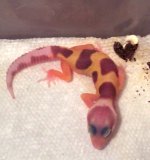Franks_Geckos
New member
I am compelled to reopen the debate over whether or not the Jungle morph (or characteristic) is actually the result of a simple recessive gene. Let me start by stating the evidence that I have accumulated over the last two and a half years. In July of 2003, I bred a male Rainwater Albino (from K. Hanley) with a female Jungle (from R. Hamper). The result of this breeding was two fertile eggs that hatched a day apart in September, 2003. One turned out to be a female and the other one a male. The male looked very much like a normal and the female was a nice high yellow with some aberrant body and head markings but without the “jungle tail”. Obviously, both were 100% het for Rainwater Albino. I kept both hatchlings, at the time believing Jungle was a simple recessive, with the hope of breeding the hatchlings back to one of their parents to produce both Jungles and Albinos in 2004. In 2004, I bred the Normal (het for RWA) male back to his Jungle mother and of approximately 12 hatchlings she produced, only 2 were Jungle and all the rest were normal or high yellows. I bred the HY (het for RWA) female back to her Rainwater Albino father later in the season and produced only one fertile clutch out of 4 eggs. She was a bit young for her size and I believe that is the reason why half of the eggs were duds. Of these 2 hatchlings, one was a Banded Rainwater Albino and the other was a Normal (het for Albino). From the results of the 2004 breeding, I found that there were significantly fewer jungles produced than I would have anticipated (2 of 12 is not even close to approx. 50%). I know that the simple recessives only work based on a theorized percentage and that you don’t always get exact numbers of what should be produced, but still, 2 of 12 was not even close.
This year, uncertain of the true nature of the Jungle characteristic, I bred the clutch-mates that hatched in 2003 to each other. So far this season I have produced 3 hatchlings from this pair. Two hatchlings are Jungle (with the incomplete banding of the tail used as the commonly accepted criteria for determining the presence of the trait) and the third is a Rainwater Jungle Albino (with an almost perfectly striped tail). There are still quite a few eggs cooking from this pair, and time will tell what the final numbers will be, however, IF YOU BELIEVE that jungle is a simple recessive, then my odds of producing hatchlings that appear Jungle are 1 in 4 from these two geckos. My odds of producing an Albino Jungle are 1 in 16. For me to get 3 of 3 hatchlings to be outwardly appearing Jungle (1 of these 3 also being Albino) from these geckos is amazing, almost unbelievable, and it happened!
THEREFORE, I believe that my evidence suggests that 1 in 3 of my current hatchlings from this pair being Albino is realistic simple recessive genetics at work, and that the Jungle characteristic is actually a strange trait that may show itself more frequently when two “trait carrying” geckos that carry similar amounts of whatever cause this trait to appear, breed. It’s the only explanation I can come up with of why when I bred my male back to his mother (who was a jungle) I only hatched 2 of 12 jungles, while when I bred him to his sister (not appearing to be jungle either) I am 3 for 3 thus far. Does anyone else have similar experiences with this trait? I have attached a picture of the nice Rainwater Jungle Albino hatchling.
This year, uncertain of the true nature of the Jungle characteristic, I bred the clutch-mates that hatched in 2003 to each other. So far this season I have produced 3 hatchlings from this pair. Two hatchlings are Jungle (with the incomplete banding of the tail used as the commonly accepted criteria for determining the presence of the trait) and the third is a Rainwater Jungle Albino (with an almost perfectly striped tail). There are still quite a few eggs cooking from this pair, and time will tell what the final numbers will be, however, IF YOU BELIEVE that jungle is a simple recessive, then my odds of producing hatchlings that appear Jungle are 1 in 4 from these two geckos. My odds of producing an Albino Jungle are 1 in 16. For me to get 3 of 3 hatchlings to be outwardly appearing Jungle (1 of these 3 also being Albino) from these geckos is amazing, almost unbelievable, and it happened!
THEREFORE, I believe that my evidence suggests that 1 in 3 of my current hatchlings from this pair being Albino is realistic simple recessive genetics at work, and that the Jungle characteristic is actually a strange trait that may show itself more frequently when two “trait carrying” geckos that carry similar amounts of whatever cause this trait to appear, breed. It’s the only explanation I can come up with of why when I bred my male back to his mother (who was a jungle) I only hatched 2 of 12 jungles, while when I bred him to his sister (not appearing to be jungle either) I am 3 for 3 thus far. Does anyone else have similar experiences with this trait? I have attached a picture of the nice Rainwater Jungle Albino hatchling.




